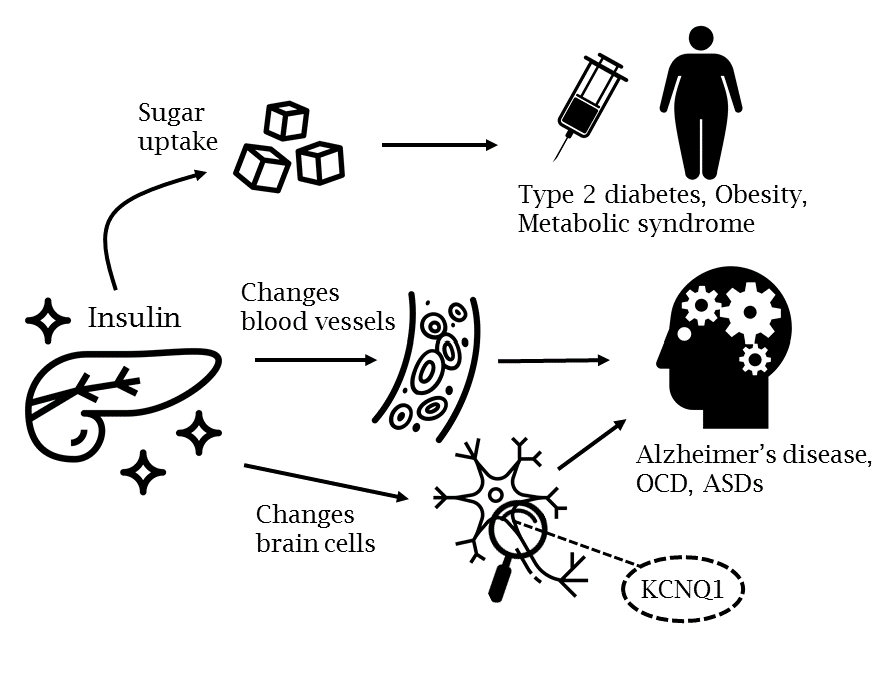-
Home
PRIME explained
The project explained
A document summarizing the main goals of the project can be downloaded here.
Multimorbidity of insulin-related somatic and brain diseases
When a person has multiple diseases, this is called comorbidity or multimorbidity. This is often the case for insulin-related somatic diseases, in particular type 2 diabetes [Infographic: “What is type 2 diabetes?”], metabolic syndrome, obesity and Romano-Ward Syndrome (a genetic heart condition). Patients with these diseases frequently have comorbid brain disorders such as Alzheimer’s disease, obsessive-compulsive disorder (OCD) or autism spectrum disorders (ASDs). And vice versa, people who have these brain diseases often experience problems with the body’s insulin signaling system. This means that insulin-related signaling mechanisms may play a role in the multimorbidity of somatic and brain diseases. Understanding these mechanisms will improve the diagnosis and treatment of these conditions, and this is what the PRIME project is investigating.
The role of insulin in brain diseases
How can insulin mechanisms play a role in both somatic and brain diseases? In our body, insulin mainly stimulates sugar uptake after eating a meal. While in our brain [Infographic: “Diabetes in the brain”], insulin plays an additional, important role in the survival of brain cells and regulating brain function. We know that insulin signaling in our body interacts with insulin signaling in our brain. For example, disturbances in insulin signaling can trigger immune reactions that in turn influence changes in blood vessels of the brain. Insulin can also more directly influence brain processes, for instance, those involved in memory and mental flexibility.
Medication for type 2 diabetes is currently being tested as a potential new treatment for Alzheimer’s disease [Infographic: “Diabetes and Alzheimer’s disease”]. The first results seem to indicate that this medication may indeed reduce Alzheimer’s symptoms [1]. Other research has shown that there is a genetic overlap between insulin signaling, OCD [2] and ASDs [3].
In the PRIME project, we therefore hypothesize that disturbances in insulin signaling may lead to a failure to adopt new behavioural strategies, and that this inflexibility is an important common feature between insulin-related brain diseases. We investigate if differences in insulin signaling in the brain (that may be triggered by impairments of insulin signaling in the body) will lead to changes in behaviour that are linked to OCD, ASDs and Alzheimer’s disease.
The molecule KCNQ1
Insulin signaling in the brain is composed of several components, but one key molecule is of particular interest to the PRIME consortium: KCNQ1. KCNQ1 is a voltage-gated potassium channel that plays a role in stopping neurons from secreting insulin. We focus on this molecule because a genetic link between KCNQ1 and OCD, type 2 diabetes and Alzheimer’s disease has previously been found [4]. It is, therefore, an interesting candidate to better understand the multimorbidity between these diseases.
Furthermore, Romano-Ward Syndrome (RWS) is a rare disorder caused by defects in the KCNQ1 gene. RWS patients often have insulin resistance, which is a hallmark of type 2 diabetes. In PRIME, we will also study the behavioural and cognitive characteristics of these patients to further understand the role of KCNQ1 in insulin-related multimorbidity.
We will also use animal models to study the role of KCNQ1 in insulin signaling and its effect on the brain. Our own initial studies have shown that both mice with type 2 diabetes and ‘normal’ mice displayed very compulsive behaviour when their KCNQ1 gene was disrupted.
